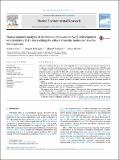Transcriptomes analysis of Aeromonas molluscorum Av27 cells exposed to tributyltin (TBT) : unravelling the effects from the molecular level to the organism
Abstract
Aeromonas molluscorum Av27 cells were exposed to 0, 5 and 50 μM of TBT and the respective transcriptomes were obtained by pyrosequencing. Gene Ontology revealed that exposure to 5 μM TBT results in a higher number of repressed genes in contrast with 50 μM of TBT, where the number of over-expressed genes is greater. At both TBT concentrations, higher variations in gene expression were found in the functional categories associated with enzymatic activities, transport/binding and oxidation-reduction. A number of proteins are affected by TBT, such as the acriflavin resistance protein, several transcription-related proteins, several Hsps, ABC transporters, CorA and ZntB and other outer membrane efflux proteins, all of these involved in cellular metabolic processes, important to maintain overall cell viability. Using the STRING tool, several proteins with unknown function were related with others involved in degradation processes, such as the pyoverdine chromophore biosynthetic protein, that has been described as playing a role in the Sn-C cleavage of organotins. This approach has allowed a better understanding of the molecular effects of exposure of bacterial cells to TBT. Furthermore it contributes to the knowledge of the functional genomic aspects of bacteria exposed to this pollutant. Furthermore, the transcriptomic data gathered, and now publically available, constitute a valuable resource for comparative genome analysis.
Citation
Cruz , A , Rodrigues , R , Monsanto Pinheiro , M & Mendo , S 2015 , ' Transcriptomes analysis of Aeromonas molluscorum Av27 cells exposed to tributyltin (TBT) : unravelling the effects from the molecular level to the organism ' , Marine Environmental Research , vol. 109 , pp. 132-139 . https://doi.org/10.1016/j.marenvres.2015.06.017
Publication
Marine Environmental Research
Status
Peer reviewed
ISSN
0141-1136Type
Journal article
Description
This work was supported by FCOMP-01-0124-FEDER-010630 project, co-funded by FEDER, European Funds through COMPETE and FCT within project PEst-C/MAR/LA0017/2013. Andreia Cruz was funded by the PhD grant SFRH/BD/36047/2007 from FCT and by a post-doctoral grant (BPD/UI88/2886/2013), from the project “Sustainable Use of Marine Resources” - MARES (CENTRO-07-ST24-FEDER-002033), funded by QREN, Mais Centro - Programa Operacional Regional do Centro e UE/Fundo Europeu de Desenvolvimento Regional. Bioinformatics support was provided by Miguel Pinheiro from the Bioinformatics Unit at St Andrews University funded by a Wellcome Trust ISSF grant (097831/Z/11/Z).Collections
Items in the St Andrews Research Repository are protected by copyright, with all rights reserved, unless otherwise indicated.

